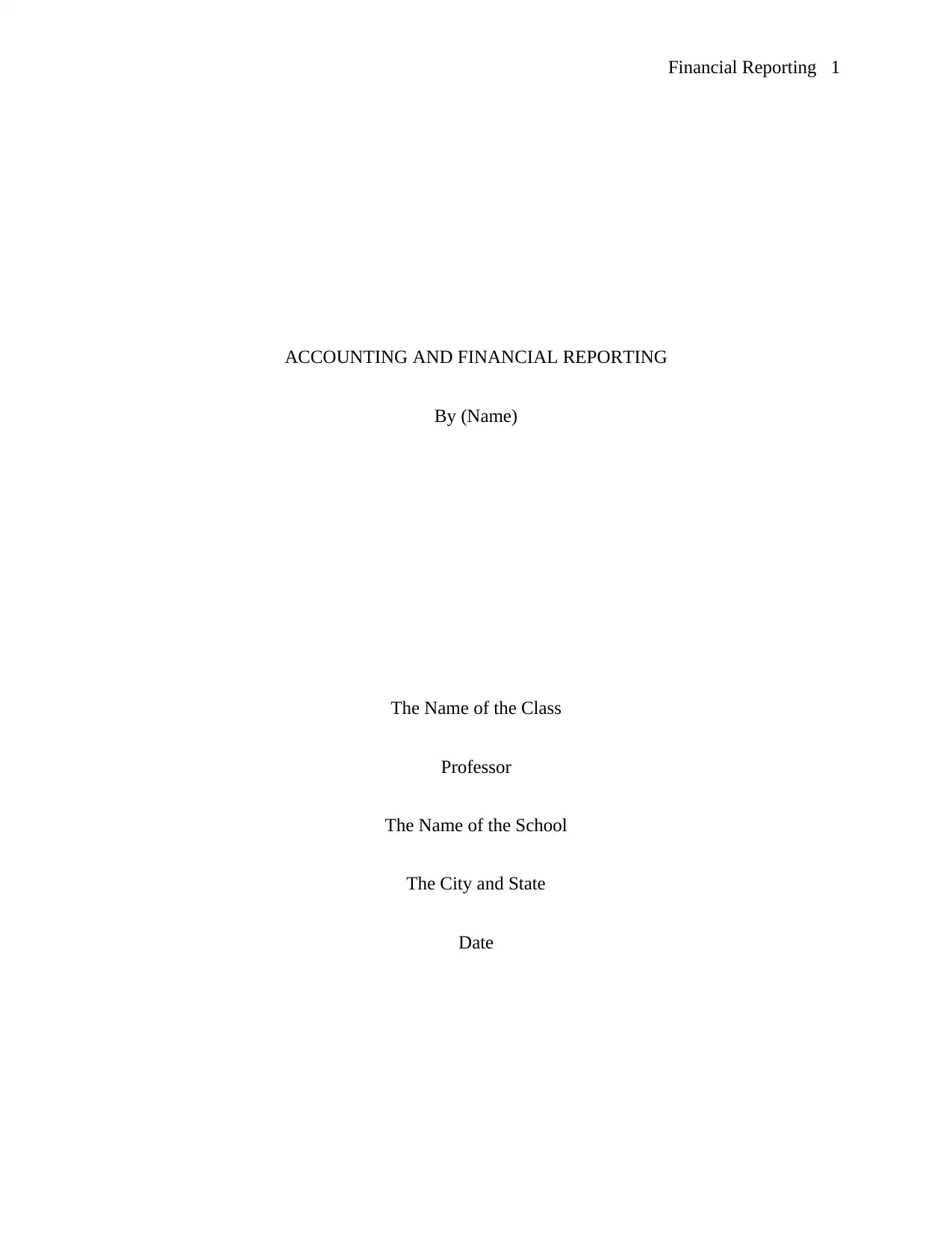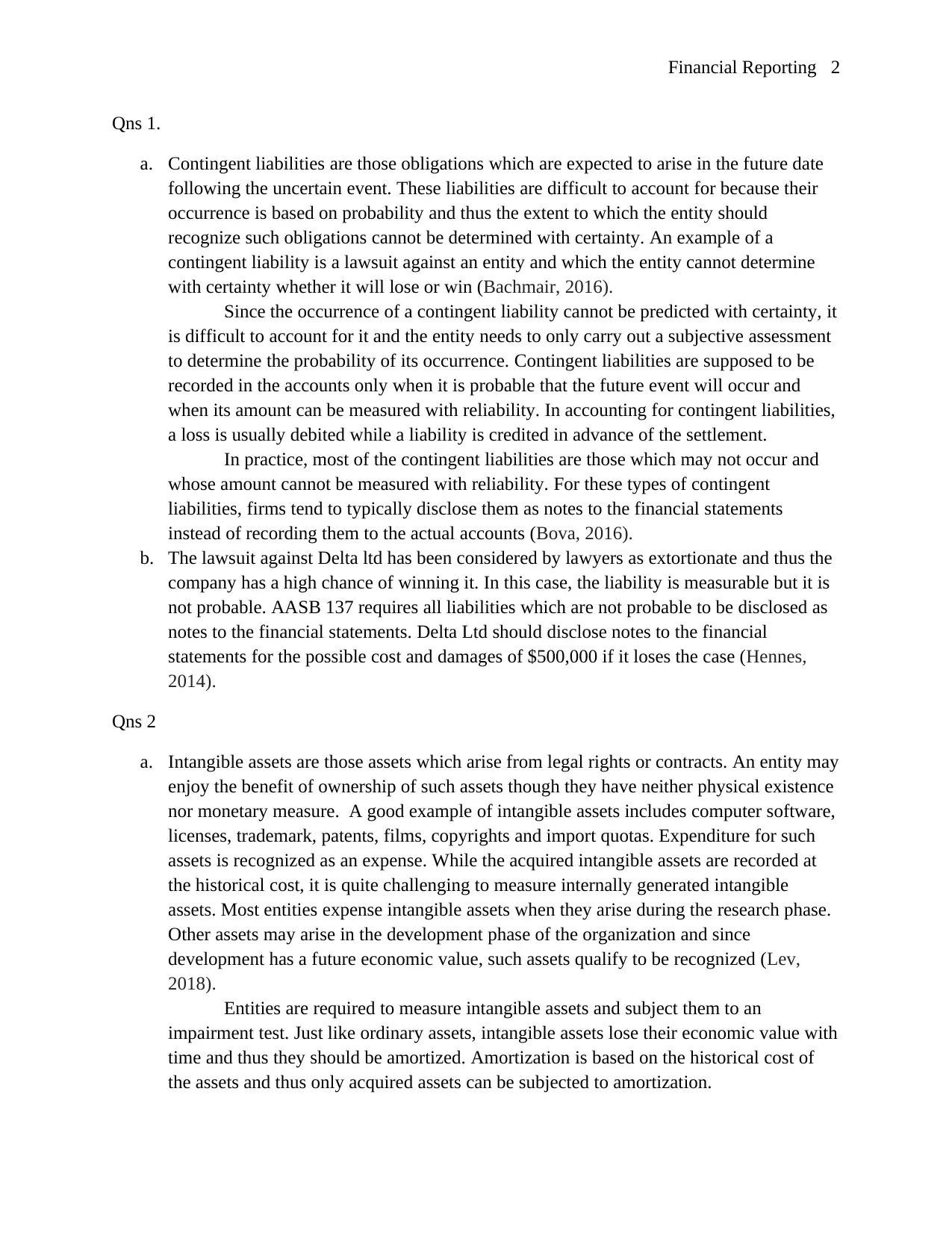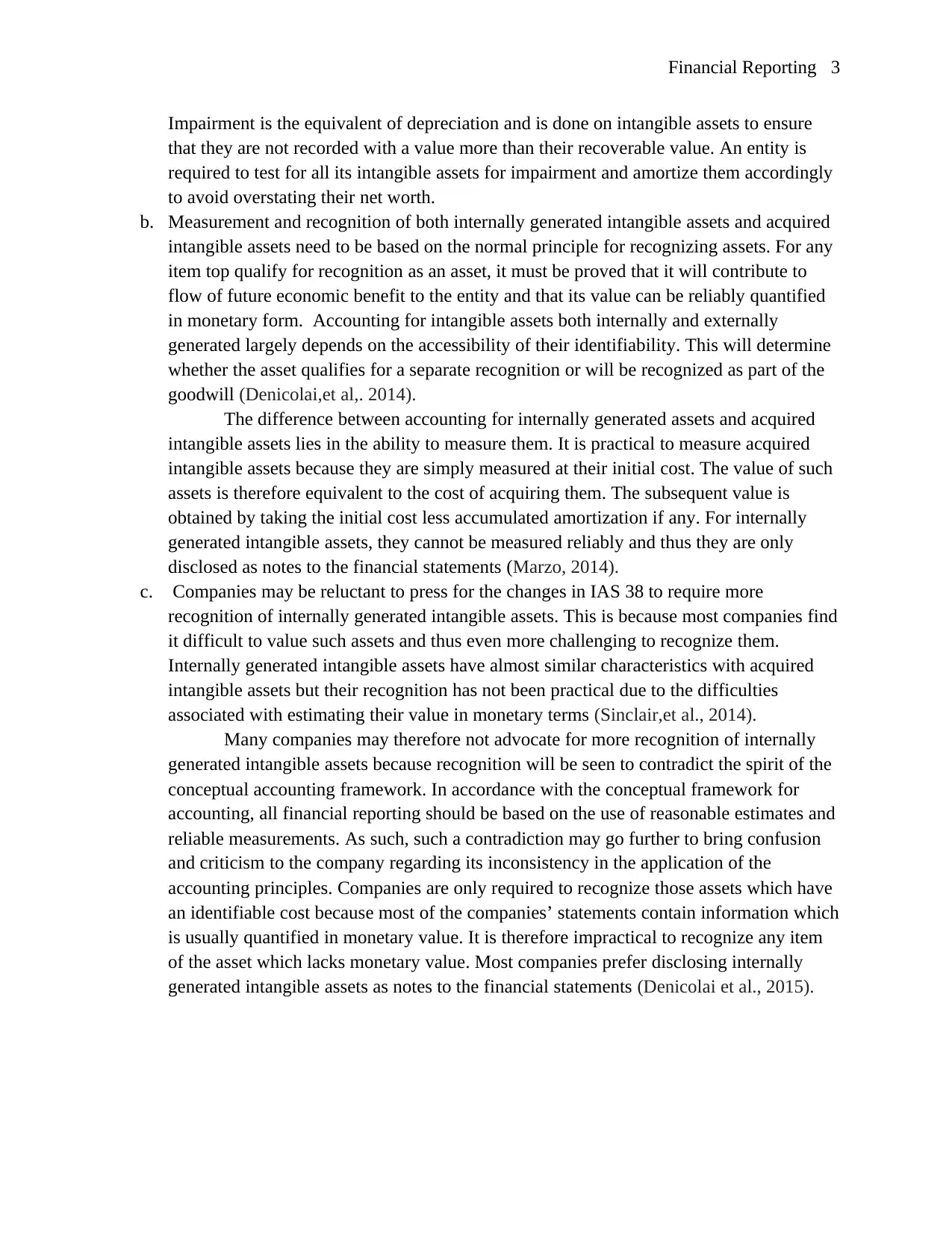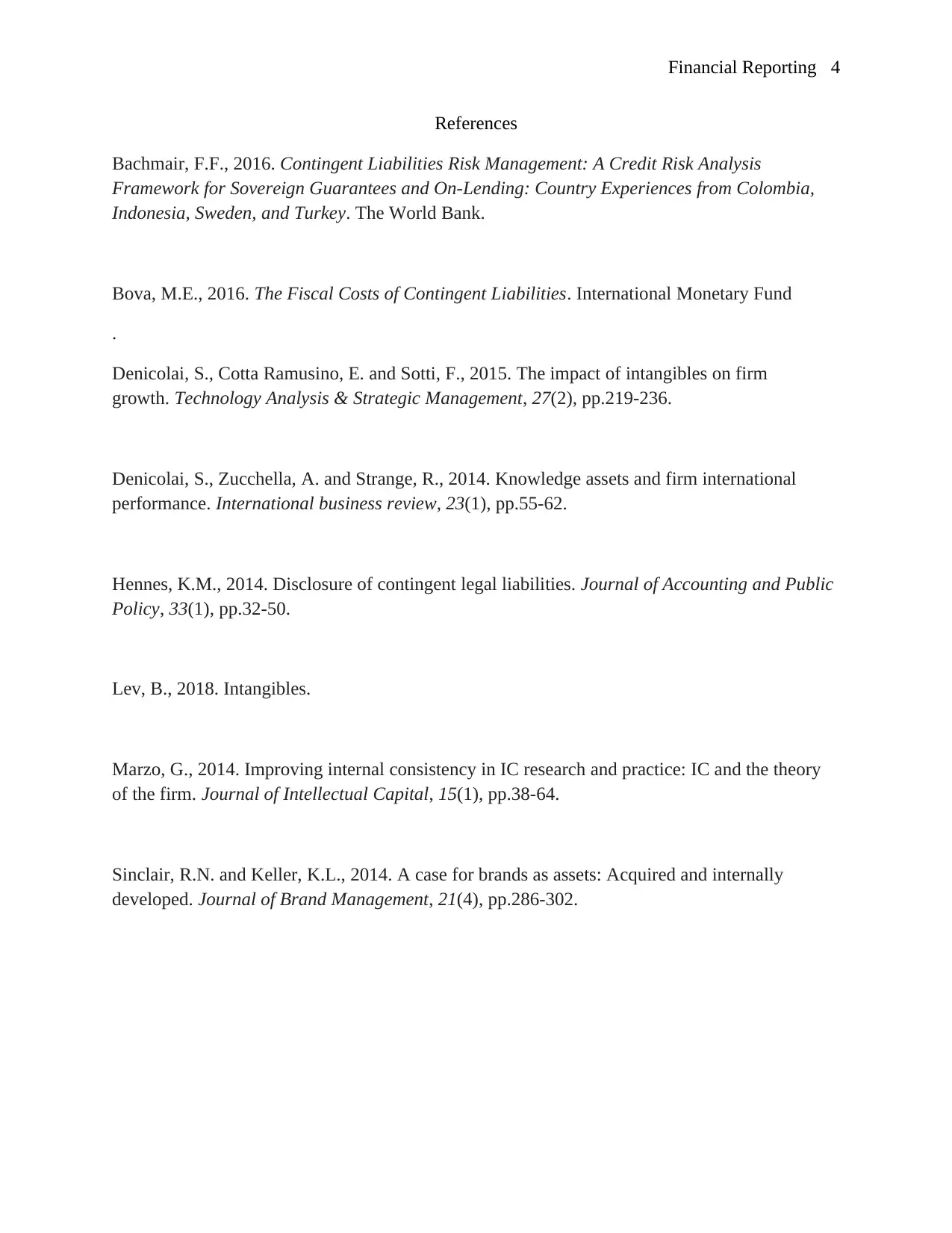Financial Reporting 1 Assignment: Liabilities, Assets, and Disclosure
VerifiedAdded on 2022/11/18
|4
|1269
|207
Homework Assignment
AI Summary
This financial reporting assignment delves into the intricacies of accounting for contingent liabilities and intangible assets. The solution addresses the recognition and disclosure of contingent liabilities, emphasizing the importance of probability and measurability as per AASB 137. It discusses the treatment of a lawsuit against Delta Ltd, highlighting the need for disclosure when a liability is measurable but not probable. The assignment also explores the nature and accounting for intangible assets, differentiating between internally generated and acquired assets. It explains the processes of amortization and impairment, stressing the importance of fair valuation. The solution further examines the challenges of measuring internally generated intangible assets and the reluctance of companies to recognize them due to valuation difficulties, referencing the conceptual accounting framework and the need for reliable measurements. The assignment concludes by emphasizing the importance of disclosing relevant information in the financial statements.

Financial Reporting 1
ACCOUNTING AND FINANCIAL REPORTING
By (Name)
The Name of the Class
Professor
The Name of the School
The City and State
Date
ACCOUNTING AND FINANCIAL REPORTING
By (Name)
The Name of the Class
Professor
The Name of the School
The City and State
Date
Paraphrase This Document
Need a fresh take? Get an instant paraphrase of this document with our AI Paraphraser

Financial Reporting 2
Qns 1.
a. Contingent liabilities are those obligations which are expected to arise in the future date
following the uncertain event. These liabilities are difficult to account for because their
occurrence is based on probability and thus the extent to which the entity should
recognize such obligations cannot be determined with certainty. An example of a
contingent liability is a lawsuit against an entity and which the entity cannot determine
with certainty whether it will lose or win (Bachmair, 2016).
Since the occurrence of a contingent liability cannot be predicted with certainty, it
is difficult to account for it and the entity needs to only carry out a subjective assessment
to determine the probability of its occurrence. Contingent liabilities are supposed to be
recorded in the accounts only when it is probable that the future event will occur and
when its amount can be measured with reliability. In accounting for contingent liabilities,
a loss is usually debited while a liability is credited in advance of the settlement.
In practice, most of the contingent liabilities are those which may not occur and
whose amount cannot be measured with reliability. For these types of contingent
liabilities, firms tend to typically disclose them as notes to the financial statements
instead of recording them to the actual accounts (Bova, 2016).
b. The lawsuit against Delta ltd has been considered by lawyers as extortionate and thus the
company has a high chance of winning it. In this case, the liability is measurable but it is
not probable. AASB 137 requires all liabilities which are not probable to be disclosed as
notes to the financial statements. Delta Ltd should disclose notes to the financial
statements for the possible cost and damages of $500,000 if it loses the case (Hennes,
2014).
Qns 2
a. Intangible assets are those assets which arise from legal rights or contracts. An entity may
enjoy the benefit of ownership of such assets though they have neither physical existence
nor monetary measure. A good example of intangible assets includes computer software,
licenses, trademark, patents, films, copyrights and import quotas. Expenditure for such
assets is recognized as an expense. While the acquired intangible assets are recorded at
the historical cost, it is quite challenging to measure internally generated intangible
assets. Most entities expense intangible assets when they arise during the research phase.
Other assets may arise in the development phase of the organization and since
development has a future economic value, such assets qualify to be recognized (Lev,
2018).
Entities are required to measure intangible assets and subject them to an
impairment test. Just like ordinary assets, intangible assets lose their economic value with
time and thus they should be amortized. Amortization is based on the historical cost of
the assets and thus only acquired assets can be subjected to amortization.
Qns 1.
a. Contingent liabilities are those obligations which are expected to arise in the future date
following the uncertain event. These liabilities are difficult to account for because their
occurrence is based on probability and thus the extent to which the entity should
recognize such obligations cannot be determined with certainty. An example of a
contingent liability is a lawsuit against an entity and which the entity cannot determine
with certainty whether it will lose or win (Bachmair, 2016).
Since the occurrence of a contingent liability cannot be predicted with certainty, it
is difficult to account for it and the entity needs to only carry out a subjective assessment
to determine the probability of its occurrence. Contingent liabilities are supposed to be
recorded in the accounts only when it is probable that the future event will occur and
when its amount can be measured with reliability. In accounting for contingent liabilities,
a loss is usually debited while a liability is credited in advance of the settlement.
In practice, most of the contingent liabilities are those which may not occur and
whose amount cannot be measured with reliability. For these types of contingent
liabilities, firms tend to typically disclose them as notes to the financial statements
instead of recording them to the actual accounts (Bova, 2016).
b. The lawsuit against Delta ltd has been considered by lawyers as extortionate and thus the
company has a high chance of winning it. In this case, the liability is measurable but it is
not probable. AASB 137 requires all liabilities which are not probable to be disclosed as
notes to the financial statements. Delta Ltd should disclose notes to the financial
statements for the possible cost and damages of $500,000 if it loses the case (Hennes,
2014).
Qns 2
a. Intangible assets are those assets which arise from legal rights or contracts. An entity may
enjoy the benefit of ownership of such assets though they have neither physical existence
nor monetary measure. A good example of intangible assets includes computer software,
licenses, trademark, patents, films, copyrights and import quotas. Expenditure for such
assets is recognized as an expense. While the acquired intangible assets are recorded at
the historical cost, it is quite challenging to measure internally generated intangible
assets. Most entities expense intangible assets when they arise during the research phase.
Other assets may arise in the development phase of the organization and since
development has a future economic value, such assets qualify to be recognized (Lev,
2018).
Entities are required to measure intangible assets and subject them to an
impairment test. Just like ordinary assets, intangible assets lose their economic value with
time and thus they should be amortized. Amortization is based on the historical cost of
the assets and thus only acquired assets can be subjected to amortization.

Financial Reporting 3
Impairment is the equivalent of depreciation and is done on intangible assets to ensure
that they are not recorded with a value more than their recoverable value. An entity is
required to test for all its intangible assets for impairment and amortize them accordingly
to avoid overstating their net worth.
b. Measurement and recognition of both internally generated intangible assets and acquired
intangible assets need to be based on the normal principle for recognizing assets. For any
item top qualify for recognition as an asset, it must be proved that it will contribute to
flow of future economic benefit to the entity and that its value can be reliably quantified
in monetary form. Accounting for intangible assets both internally and externally
generated largely depends on the accessibility of their identifiability. This will determine
whether the asset qualifies for a separate recognition or will be recognized as part of the
goodwill (Denicolai,et al,. 2014).
The difference between accounting for internally generated assets and acquired
intangible assets lies in the ability to measure them. It is practical to measure acquired
intangible assets because they are simply measured at their initial cost. The value of such
assets is therefore equivalent to the cost of acquiring them. The subsequent value is
obtained by taking the initial cost less accumulated amortization if any. For internally
generated intangible assets, they cannot be measured reliably and thus they are only
disclosed as notes to the financial statements (Marzo, 2014).
c. Companies may be reluctant to press for the changes in IAS 38 to require more
recognition of internally generated intangible assets. This is because most companies find
it difficult to value such assets and thus even more challenging to recognize them.
Internally generated intangible assets have almost similar characteristics with acquired
intangible assets but their recognition has not been practical due to the difficulties
associated with estimating their value in monetary terms (Sinclair,et al., 2014).
Many companies may therefore not advocate for more recognition of internally
generated intangible assets because recognition will be seen to contradict the spirit of the
conceptual accounting framework. In accordance with the conceptual framework for
accounting, all financial reporting should be based on the use of reasonable estimates and
reliable measurements. As such, such a contradiction may go further to bring confusion
and criticism to the company regarding its inconsistency in the application of the
accounting principles. Companies are only required to recognize those assets which have
an identifiable cost because most of the companies’ statements contain information which
is usually quantified in monetary value. It is therefore impractical to recognize any item
of the asset which lacks monetary value. Most companies prefer disclosing internally
generated intangible assets as notes to the financial statements (Denicolai et al., 2015).
Impairment is the equivalent of depreciation and is done on intangible assets to ensure
that they are not recorded with a value more than their recoverable value. An entity is
required to test for all its intangible assets for impairment and amortize them accordingly
to avoid overstating their net worth.
b. Measurement and recognition of both internally generated intangible assets and acquired
intangible assets need to be based on the normal principle for recognizing assets. For any
item top qualify for recognition as an asset, it must be proved that it will contribute to
flow of future economic benefit to the entity and that its value can be reliably quantified
in monetary form. Accounting for intangible assets both internally and externally
generated largely depends on the accessibility of their identifiability. This will determine
whether the asset qualifies for a separate recognition or will be recognized as part of the
goodwill (Denicolai,et al,. 2014).
The difference between accounting for internally generated assets and acquired
intangible assets lies in the ability to measure them. It is practical to measure acquired
intangible assets because they are simply measured at their initial cost. The value of such
assets is therefore equivalent to the cost of acquiring them. The subsequent value is
obtained by taking the initial cost less accumulated amortization if any. For internally
generated intangible assets, they cannot be measured reliably and thus they are only
disclosed as notes to the financial statements (Marzo, 2014).
c. Companies may be reluctant to press for the changes in IAS 38 to require more
recognition of internally generated intangible assets. This is because most companies find
it difficult to value such assets and thus even more challenging to recognize them.
Internally generated intangible assets have almost similar characteristics with acquired
intangible assets but their recognition has not been practical due to the difficulties
associated with estimating their value in monetary terms (Sinclair,et al., 2014).
Many companies may therefore not advocate for more recognition of internally
generated intangible assets because recognition will be seen to contradict the spirit of the
conceptual accounting framework. In accordance with the conceptual framework for
accounting, all financial reporting should be based on the use of reasonable estimates and
reliable measurements. As such, such a contradiction may go further to bring confusion
and criticism to the company regarding its inconsistency in the application of the
accounting principles. Companies are only required to recognize those assets which have
an identifiable cost because most of the companies’ statements contain information which
is usually quantified in monetary value. It is therefore impractical to recognize any item
of the asset which lacks monetary value. Most companies prefer disclosing internally
generated intangible assets as notes to the financial statements (Denicolai et al., 2015).
⊘ This is a preview!⊘
Do you want full access?
Subscribe today to unlock all pages.

Trusted by 1+ million students worldwide

Financial Reporting 4
References
Bachmair, F.F., 2016. Contingent Liabilities Risk Management: A Credit Risk Analysis
Framework for Sovereign Guarantees and On-Lending: Country Experiences from Colombia,
Indonesia, Sweden, and Turkey. The World Bank.
Bova, M.E., 2016. The Fiscal Costs of Contingent Liabilities. International Monetary Fund
.
Denicolai, S., Cotta Ramusino, E. and Sotti, F., 2015. The impact of intangibles on firm
growth. Technology Analysis & Strategic Management, 27(2), pp.219-236.
Denicolai, S., Zucchella, A. and Strange, R., 2014. Knowledge assets and firm international
performance. International business review, 23(1), pp.55-62.
Hennes, K.M., 2014. Disclosure of contingent legal liabilities. Journal of Accounting and Public
Policy, 33(1), pp.32-50.
Lev, B., 2018. Intangibles.
Marzo, G., 2014. Improving internal consistency in IC research and practice: IC and the theory
of the firm. Journal of Intellectual Capital, 15(1), pp.38-64.
Sinclair, R.N. and Keller, K.L., 2014. A case for brands as assets: Acquired and internally
developed. Journal of Brand Management, 21(4), pp.286-302.
References
Bachmair, F.F., 2016. Contingent Liabilities Risk Management: A Credit Risk Analysis
Framework for Sovereign Guarantees and On-Lending: Country Experiences from Colombia,
Indonesia, Sweden, and Turkey. The World Bank.
Bova, M.E., 2016. The Fiscal Costs of Contingent Liabilities. International Monetary Fund
.
Denicolai, S., Cotta Ramusino, E. and Sotti, F., 2015. The impact of intangibles on firm
growth. Technology Analysis & Strategic Management, 27(2), pp.219-236.
Denicolai, S., Zucchella, A. and Strange, R., 2014. Knowledge assets and firm international
performance. International business review, 23(1), pp.55-62.
Hennes, K.M., 2014. Disclosure of contingent legal liabilities. Journal of Accounting and Public
Policy, 33(1), pp.32-50.
Lev, B., 2018. Intangibles.
Marzo, G., 2014. Improving internal consistency in IC research and practice: IC and the theory
of the firm. Journal of Intellectual Capital, 15(1), pp.38-64.
Sinclair, R.N. and Keller, K.L., 2014. A case for brands as assets: Acquired and internally
developed. Journal of Brand Management, 21(4), pp.286-302.
1 out of 4
Related Documents
Your All-in-One AI-Powered Toolkit for Academic Success.
+13062052269
info@desklib.com
Available 24*7 on WhatsApp / Email
![[object Object]](/_next/static/media/star-bottom.7253800d.svg)
Unlock your academic potential
Copyright © 2020–2025 A2Z Services. All Rights Reserved. Developed and managed by ZUCOL.





